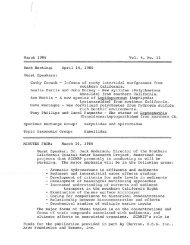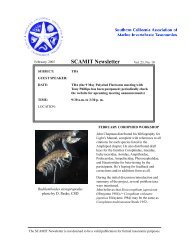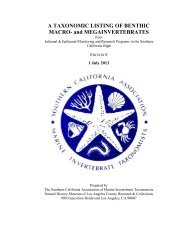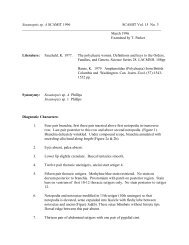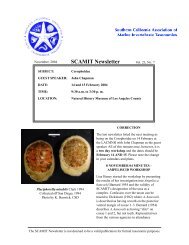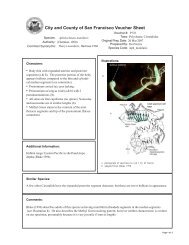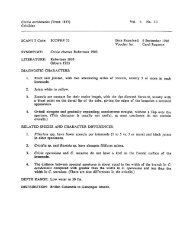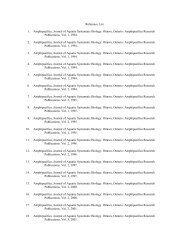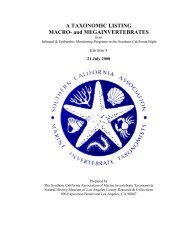Key to genera of Terebellidae - scamit
Key to genera of Terebellidae - scamit
Key to genera of Terebellidae - scamit
You also want an ePaper? Increase the reach of your titles
YUMPU automatically turns print PDFs into web optimized ePapers that Google loves.
<strong>Key</strong> <strong>to</strong> the <strong>genera</strong> and some species <strong>of</strong> <strong>Terebellidae</strong> <strong>of</strong> the OCSD Ocean Moni<strong>to</strong>ring Program<br />
1. Buccal region modified as a large, non‐retracle, “proboscis” .. Artacama coniferi<br />
Hartman, 1969<br />
Buccal region not modified as a large proboscis .................................................... 2<br />
2. Uncini absent ........................................................................ Amaeana occidentalis<br />
Lateral<br />
view<br />
mouth<br />
feeding tentacles<br />
Hartman, 1969<br />
Ventral<br />
view<br />
Uncini present ........................................................................................................ 3<br />
3. Branchiae absent .................................................................................................... 4<br />
Branchieae present ................................................................................................ 5<br />
4. All uncini in single rows ........................................................................... Polycirrus<br />
At least some uncini in double rows .............................. Phisidia/Lanassa/Proclea<br />
R. Rowe<br />
m. g. stain<br />
Kritzler, 1984<br />
Holthe, 1986<br />
5. Branchiae tus <strong>of</strong> sessile filaments ........................................................................ 6<br />
Hartman, 1969<br />
Branchiae branching <strong>of</strong>f one or more stems .......................................................... 7<br />
K. Barwick/May, 2009(Revised July, 2009)/<strong>Terebellidae</strong><br />
Page 1 <strong>of</strong> 3<br />
Hartman, 1969
6. First no<strong>to</strong>setae on first branchial segment ......................................... Streblosoma<br />
First no<strong>to</strong>setae on second branchial segment .......................................... Thelepus<br />
7. Thoracic uncini pecnate ..................................................................... Loimia sp A<br />
Kritzler, 1984<br />
Thoracic uncini avicular .......................................................................................... 8<br />
m. g. stain<br />
Kritzler, 1984<br />
8. First four segments with lateral lappets modified in<strong>to</strong> a plaque .............................<br />
.................................................................................................... Scionella japonica<br />
branchiae<br />
mouth<br />
Hartman, 1969<br />
Lateral lappets not modified in<strong>to</strong> plaque ............................................................... 9<br />
9. Uncini <strong>of</strong> first seger with long basal shas; double rows <strong>of</strong> uncini arranged<br />
face‐<strong>to</strong>‐face ...................................................................................................... Pista<br />
basal sha<br />
m. g. stain<br />
L. Lovell<br />
All thoracic uncini with short basal shas; uncini in double rows arranged<br />
face‐<strong>to</strong>‐face or back‐<strong>to</strong>‐back ................................................................................ 10<br />
basal sha<br />
K. Barwick/May, 2009(Revised July, 2009)/<strong>Terebellidae</strong><br />
Page 2 <strong>of</strong> 3
10. Methyl green stain paern <strong>of</strong> bold lateral stripes down both sides <strong>of</strong> the animal<br />
................................................................................................... Lanice conchilega 1<br />
tube<br />
Holthe, 1986<br />
Methyl green staining stripes absent .................................................. Eupolymnia 2<br />
1 Check also Pista moorei which has similarly staining stripes.<br />
2 Small juvenile Pista can be confused here, compare methyl green staining paern with Pista spp. Bring <strong>to</strong><br />
specialist.<br />
K. Barwick/May, 2009(Revised July, 2009)/<strong>Terebellidae</strong><br />
Page 3 <strong>of</strong> 3



